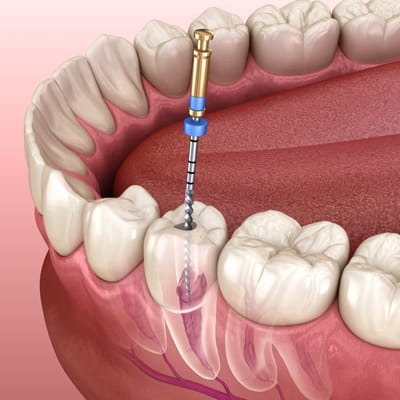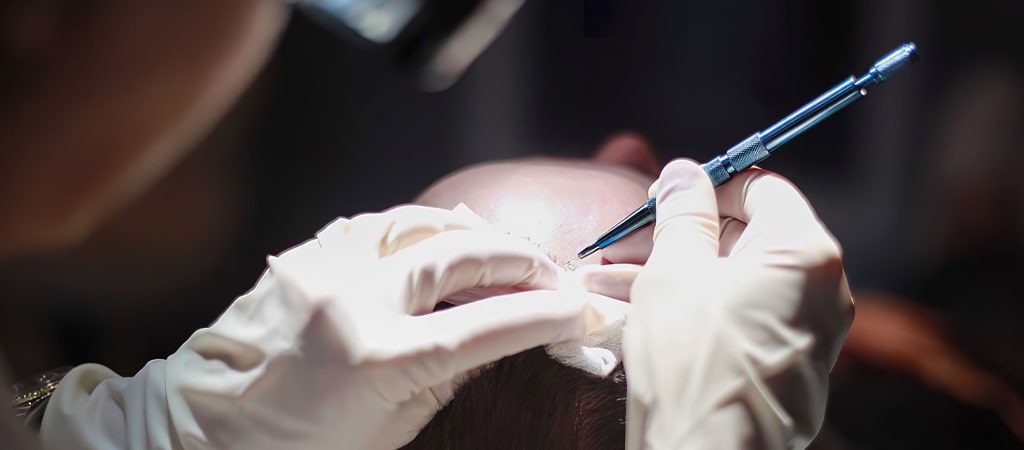What Is A Root Canal Treatment?

A Root canal treatment – Endodontics, is a dental procedure to repair a tooth by removing the pulplayer damaged by decay or infection. The procedure involves removing the pulp layer (soft tissue called the root canal) and the dental nerve, cleaning the internal structure, then the cavity in the tooth is filled with a filling.
Toothaches are a result of inflammation of dental nerves, and this happens when the treatment of tooth decay is left too late.
When tooth problems are treated late, the inflammation of the nerves reaches down to the roots of the tooth, causing extreme pain.
Removal of the intra-canal nerves prevents pain. Dental nerves are only a sensory structure responsible for sending hot and cold sensation. If the tooth is left untreated, it can lead to problems such as infection, spread to other teeth, and abscess in the surrounding tissue.

Which Cases Would Require A Root Canal Treatment?
The requirement for a root canal is mainly due to deep decay, cavities and cracks in the teeth. If the internal structure of the tooth is too damaged to heal, the pulp is removed to protect the tooth. Therefore, the biggest benefit of a root canal is to save the dead tooth without losing the bone structure of the tooth. Some of the symptoms that may indicate the requirement for treatment include:
- Sensitivity during eating and drinking
- Sharp pain in the gums
- Abscesses in the tooth
- Fractures and cracks in the teeth
- Gingival discoloration
- Pimples or sores on the gums
- Swelling of the gums
How Is A Root Canal Treatment Performed?
An Endodontic procedure has four main goals: to repair the decay and infection, to shape the tooth canal, to fill the tooth canal and to restore use of the tooth. Depending on the condition of the teeth, the treatment may take 1-2 sessions. Although the procedure varies according to the damage of the tooth, the following stages are generally applied in the procedure
- X-rays are taken before the damage to the tooth can be detected.
- After the x-ray, the teeth are examined to assess whether or not there are signs of infection in the root of the tooth. If there are no infections, the treatment gets started on.
- Local anesthesia is applied.
- The patient’s mouth is cleaned to remove bacteria and saliva.
- Decay is removed by drilling a hole in the tooth.
- In cases where the tooth pulp is badly damaged, the dentist carefully removes it.
- The root canals are cleaned and reshaped. The procedure takes about 1 hour.
- Using specially sized files, the doctor removes all bacteria and cleans the areas off of decays and damages. Once the procedure is complete, the tooth is disinfected and a temporary filling is placed on the tooth. The tooth then needs to heal for a few days.
- In the last session, the temporary filling is removed and a permanent filling is applied. The filling material protects the root and canal and prevents leakage.
How Many Sessions Does A Root Canal Consist Of?
A Root canal treatment can be completed in one or two sessions depending on the severity of the damage and the repair of the problems in the teeth. Each session takes a minimum of approximately thirty minutes depending on the size of the decay in the patient’s tooth. While fillings may be sufficient for smaller cavities, root canals may be required when there are cavities in several teeth. The treatment last step involves covering the tooth to prevent the same problems from recurring.
In cases where there is a build up of cavities that turn into an infection, it is important that the infection is first dried up before continuing. Your doctor first ensures that the inflammation dries up by applying antibiotic treatment. The treatment can then be applied after the infection dries up. If the patient experiences pain after the treatment, it is recommended by the doctor to drink painkillers.
Recovery Process In Root Canal Treatment
Recovery times for a root canal depends on the extent of the tooth damage. After the treatment, the patient can consume food after a few hours, if the root canal is a two stage treatment, the patient is advised not to consume hard foods with the temporary filling. Patients should also avoid very cold and hot drinks.
Extra points to be considered after a root canal treatment are as follows:
- Thorough oral and dental care should be taken after a root canal to avoid recurrence. Brushing should be performed with soft and circular movements without using hard and harsh motions. Dental floss should also be used once a day.
- Breaking hard shelled foods, like pistachios, damages teeth. Dentists recommend not to break the shells even if the teeth are healthy. This action should be avoided, especially with teeth that have undergone a root canal treatment.
- During and after the treatment, painkillers and/or other medications prescribed by the doctor should be used regularly.
- It is also important not to consume sweet and sticky foods immediately after the treatment.
Is An Endodontics Procedure Painful?
During the treatment the patient is given local anesthetic to curb the pain. After the treatment, the doctor will prescribe painkillers.
Feelings of sensitivity and mild pain are normal in the treated areas. It’s important to note that this treatment is to prevent tooth loss. In cases of tooth loss, patients will require more costly and longer treatments like implants and prostheses.
What Precautions Can Be Taken To Avoid The Need Of A Root Canal?
A Root canal procedure repairs the damages on a tooth and ensures that the tooth can be used as per normal again. At the same time, broken, cracked and teeth with decays that do not look aesthetically pleasing are treated.
To ensure a healthy set of teeth together with an aesthetically pleasing smile, precautions as such can be followed:
- Regularly brushing of the teeth, twice a day.
- Paying close attention to oral hygiene and the use of mouthwash.
- Hard-shelled foods should not be broken using teeth.
- Especially people with tooth sensitivity should stay away from extremely hot and cold drinks.
People who play sports that may be exposed to hard impact should use special mouth and teeth protective equipment.
Root Canal FAQs
Is a root canal treatment painful?
Is a root canal treatment painful?
Local anesthetic is applied during the treatment to prevent any pain. Because the procedure involves removing the nerve there is no pain after the procedure is over. In some cases there may be some sensitivity which is normal and should disappear within a few days.
Is there an alternative to a root canal treatment?
Is there an alternative to a root canal treatment?
A root canal is a specific treatment to prevent the loss of teeth. Very damaged teeth can be extracted and a bridge can be placed in its spot, or the tooth can be extracted and replaced with an implant. Both of these two treatments are longer and more costly.
Can a root canal be performed on a tooth with an existing abscess?
Can a root canal be performed on a tooth with an existing abscess?
An Abscess is when the root and/or gum of the tooth is inflamed. Before a root canal procedure begins, the abscess must be dried with antibiotic treatments.
Can a tooth with a root canal treatment decay again?
Can a tooth with a root canal treatment decay again?
After a root canal, teeth should be looked after and brushed regularly as recommended by the dentist. If oral hygiene is taken care of, there will be no decay.
How long after a root canal can a patient eat?
How long after a root canal can a patient eat?
Food or drink should not be consumed for at least 3-4 hours after the treatment. This period is determined by the physician depending on the difficulty of the treatment.





